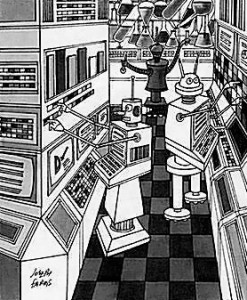The Future Of Work
Why the future of work could become child’s play.
People divide their lives into work and play. But a clever few realize that if you pick the right work it ceases to be work and becomes play. The trick is finding something that you are passionate about and then devoting your life to it. This won’t necessarily make you a fortune but it will make you happy. It may also turn you into a successful innovator, because playfulness is an essential prerequisite for invention.
In 1989 58 percent of the UK population said they were happy. By 2003, this figure had fallen to 45 percent despite a 60 percent increase in average incomes. And recently, The Observer newspaper claimed that most Britons would rather have their working hours cut than have their salaries increased. There are various explanations for all of this, but one is that people are doing the wrong kind of work. But what does the ‘wrong’ kind of work look like? The answer is highly personal, but in my experience it means working with people you dislike, doing something that’s too easy, or doing something that’s repetitive. It can also mean that you have a job that lacks meaning or doesn’t make a difference.
According to author/philosopher Charles Handy there are three forces driving change at work. The first is globalization. As Thomas Friedman argues in his book The World is Flat, there is a single global market emerging for everything from products to people. In theory this means that soon you’ll compete against everyone else on the planet for your job - although in practice there will be a limit on what gets outsourced. Nevertheless, if your job can be done cheaper somewhere else, it might be worth looking at other employment opportunities. The flip side of this global village is that if you’re really good at what you do companies will compete globally for your skills, as more jobs become mobile.
The second driver of change is demographics. Most countries face a demographic double-whammy with an aging workforce colliding with a declining birth rate. According to the Herman Group this means there will be a shortage of 10 million workers in the US by 2010. Employers will have to get smarter at attracting and retaining good people. Because of this, we can expect to see more flexible working practices and the development of initiatives that attract older workers.
For example, B&Q — a Home Depot style retailer in the UK — offers jobs to retired tradesmen. The results are improved customer service and lower employee turnover. Similarly, BMW in Germany has designed a factory to attract older workers while Procter & Gamble has developed YourEncore — a network of retirees that it dips into when it needs to crack a problem. Incidentally, one further idea implemented by P&G is ‘reverse mentoring’ that helps older workers (especially men) understand the problems faced by newly recruited staff (especially women).
The third driver of change is technology. Thanks to cellphones, laptops, and the Internet, work is becoming less tied to a physical location. Instead we are becoming a tribe of digital nomads working whenever and wherever we choose. This means that in the future employment contracts will have to change. Companies will realize that they are buying people for their ideas, and not their time or physical presence. In this scenario, annual contracts will be related to objectives met instead of hours worked. This will lead to an increase in sabbaticals and a further blurring between what’s done at home and what happens ‘at work.’
But this is just the beginning. In another twenty or thirty years artificial intelligence and robotics will have displaced another layer of workers. So if your job can be reduced to a set of formal rules that can be learnt by an intelligent and emotionally aware machine it may be worth looking for another career. It’s possible that your current profession might disappear.
In other words we are facing a third industrial revolution. The first swapped fields for factories while the second — the information revolution — replaced brawn with brains. The third revolution will be the shift from left to right-brain economic production.
During the last century people were paid to accumulate and apply information. In doing work that requires acquisition and analysis of data, workers use logical left-brain activity. But Daniel Pink, author of A Whole New Mind points out that it’s an activity that is disappearing thanks to developments in areas like computing. For instance, speech recognition and GPS systems are replacing people for taxi bookings, and websites are helping people defend themselves in trials, giving mediocre lawyers a run for their money.
For further proof of a changing worklife, consider this fascinating statistic that I recently came across. Twelve years ago, 61 percent of McKinsey’s new US recruits had MBAs. Now only around 40 percent of the recruits hold MBAs. Partially, this statistic is based on an oversupply of MBAs in the domestic market, and the fact that data analysis can be outsourced to cheaper countries. But it’s also because art graduates are demand. In a globalized world, products and services become homogenized and then commoditized. One of the best ways to create differentiation is through innovation, but what some people mean when they say innovation is actually design. Design involves the application of lateral thinking and physical beauty, both of which bring us right back to right-brain thinkers.
Of course some jobs cannot be done by a machine or outsourced to India. These include what I’d call ‘high-touch’ jobs, like nursing and teaching, both of which involve a high level of emotional intelligence. Jobs that involve the application of creativity and imagination are also safe. According to Richard Florida, one of the world’s leading social theorists and public intellectuals, these types of jobs don’t work just anywhere. There are specific types of cities that are attractive to right-brained entrepreneurs and innovators, because the score highly on the three Ts — Technology, Talent, and Tolerance. Technology refers to the proximity of world-class research facilities. Talent is the clustering of bright, like-minded people from varied backgrounds, and Tolerance is an open progressive culture that embraces ‘outsiders’ and difference.
In the new economy, child-like receptivity and cognitive flexibility may prevail. Psychological neotency, a fascinating new theory developed by Professor Bruce Charlton at the University of Newcastle-Upon-Tyne (UK), says that the increased level of immaturity among adults is an evolutionary response to increased change and uncertainty. This sounds ridiculous when you first consider it, but it does make a certain amount of sense if you stop and think about it. Historically maturity was useful because in a ‘fixed’ environment it indicated wisdom and experience. However, in a rapidly changing environment experience can actually be disabling. In other words, youthfulness and playfulness may be adaptive responses to change where jobs, skills, and technology are all in a state of flux. This could certainly explain the apparently adolescent behaviour of innovators like Richard Branson and Steve Wozniak and, if true, has profound implications for everything from HR policy to office design.
Internet Source: http://www.fastcompany.com/resources/innovation/watson/112906.html









